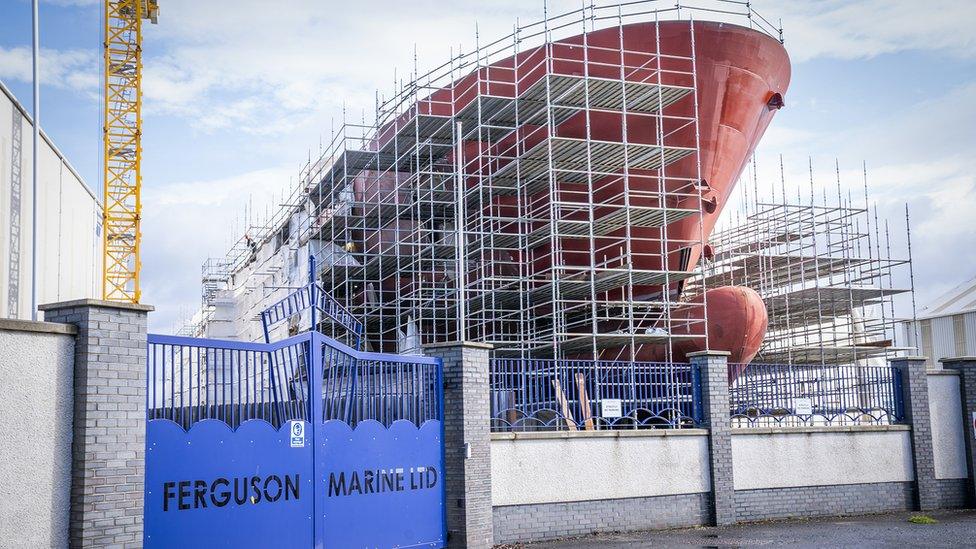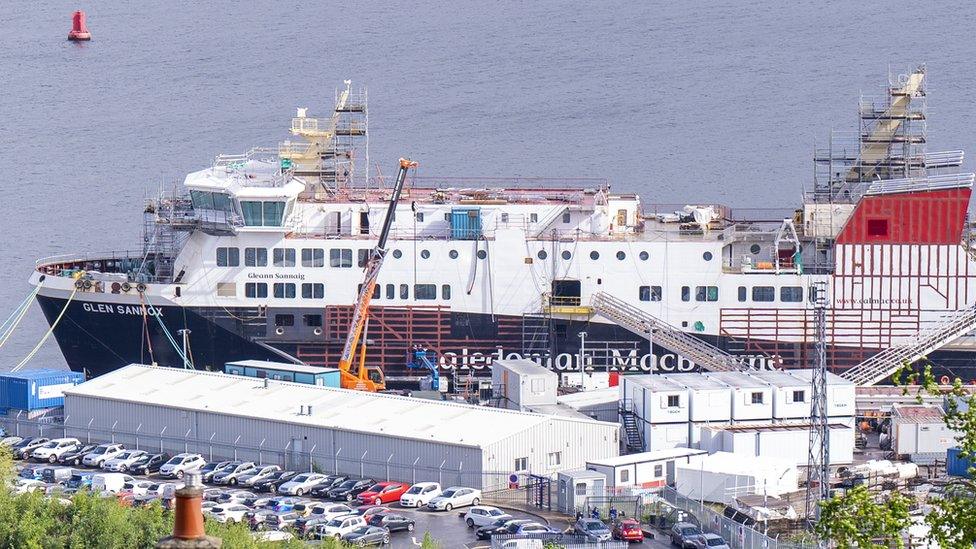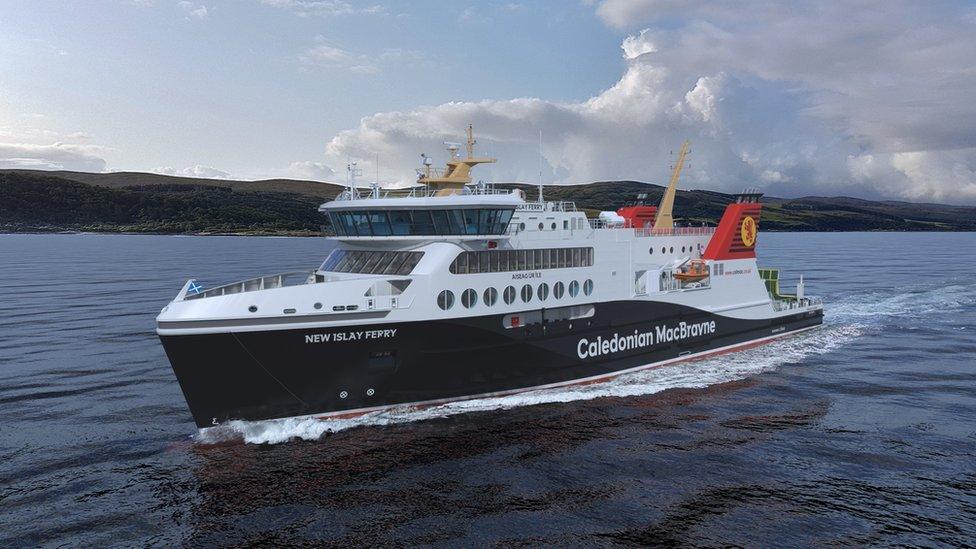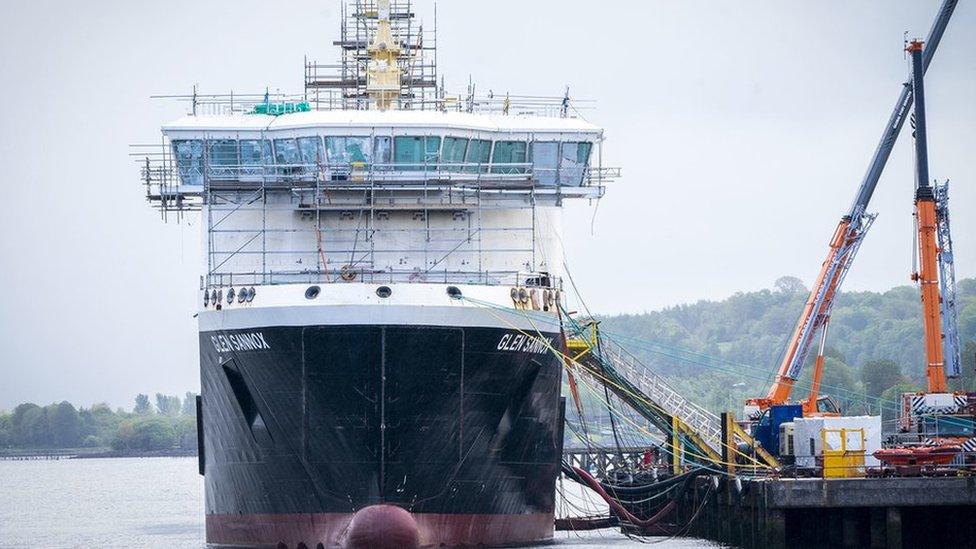Overdue CalMac ferries hit by further delays
- Published

The Glen Sannox is now not due to be handed over until the Autumn
The two CalMac ferries that are being built at the Ferguson shipyard on the Clyde have been hit by a further delay.
One of the boats - hull 801 which will be called the Glen Sannox and serve Arran - will now not be ready until the autumn rather than May of this year.
A second ferry, known as hull 802, had been due for hand over in March 2024 but will be delayed to that autumn.
Deputy First Minister John Swinney said an additional £6m would also be allocated to help complete the ferries.
This is on top of the £15m of extra funding for Ferguson Marine already provided by the Scottish government this financial year.
The ferries, which will join the CalMac fleet serving island communities, are already five years behind schedule, with the cost of the project three times more than the original £97m budget.
Announcing the latest delay in Holyrood, Mr Swinney said "persistent design gaps and build errors" meant that "progress has been slower than planned for the 801 vessel".
Mr Swinney added: "It is a matter of great disappointment that a further revision to the timescale for delivery has been necessary.
"I welcome the chief executive's assurances that Ferguson Marine will continue their best endeavours to deliver both vessels sooner than these dates.
"The chief executive has also set out plans for the MV Glen Sannox to have a sustained testing and sea trials period to help ensure a smooth entry into service later this year."
The deputy first minister said any further financial needs at Ferguson shipyard in Inverclyde, which has been in public hands since 2019, would be assessed by the government and its ferry procurement arm Caledonian Maritime Assets Limited (Cmal).
It emerged earlier this week that £87,000 was paid in bonuses to six senior managers at the nationalised shipyard between 2019 and 2022.
Scotland's public spending watchdog said it was "unacceptable" that the money had not been cleared by the Scottish government.
Asked about the bonuses, the Mr Swinney described them as "reprehensible", adding that the government was "assessing what actions we can take in that respect".
'Kick in the teeth' to islanders
Ferguson Marine chief executive David Tydeman insisted that the Glen Sannox was "coming to life" following a successful spell in drydock, with its main engines, propellers, generators and radar working.
He added: "We are obviously disappointed to extend the delivery timescales for both vessels but after sensible conversations with the broader stakeholders, there are compelling reasons for doing so.
"We will be able to hand over ships that have completed extensive sea trials and are fully equipped to run as dual fuel vessels, as originally planned."

Glen Sannox and hull 802, pictured, are still being constructed at Ferguson shipyard
Scottish Conservative shadow transport minister Graham Simpson MSP said the delays were a "disgrace" and another "kick in the teeth" to island communities and taxpayers.
"John Swinney's admission that these ferries could both be delayed by a further seven months beggars belief, given they are already more than five years late," he said.
He added: "The scale of incompetence shown by SNP ministers throughout this scandal is breath-taking."
Neil Bibby, Scottish Labour's transport spokesperson, said it was a "scandal manufactured by SNP ministers", and said both Humza Yousaf and Kate Forbes - two of the three candidates for the SNP leadership - had "their fingerprints on it".
Mr Bibby referred to the auditor general's concerns over the bonuses for senior managers.
'Difficulties and challenges'
"After all that's gone wrong, it beggars belief that management handed themselves bonuses without anyone in the SNP government even noticing," he said. "This taxpayer-funded gravy train for senior management needs to end."
He called for an independent inquiry into the "shameful debacle".
Mr Swinney replied that there had been two committee inquiries already into Ferguson Marine - one of which by the Public Audit Committee is yet to report - and it would be "premature" for him to say more.
He told MSPs that the intention of ministers had been to support the retention and development of shipbuilding on the Clyde, and reported that Ferguson Marine was pursuing commercial opportunities.
He said the problems were a matter of deep regret, for which he apologised.


The nightmare continues and stretches even further into the distance.
The two ferries being built by Ferguson shipyard have been battered by a novel design, for both diesel and liquified natural gas, being built while the design kept being changed, the financial collapse of the yard before being taken over by the Scottish government, Covid lockdowns and delays, political interference or the lack of it, skill shortages and a contractual fiasco.
There's not much surprise that delivery is further delayed from the timetable set out last March. That's clear to anyone driving past the yard.
The launch of the second ship won't take place until late next year. It's cheaper to work on the slipway than in the water, as they were reminded by the rushed launch of Glen Sannox. But at more than £300m - more than three times the original budget - these ships are still eye-wateringly expensive.
David Tydeman's update on the delivery schedule does not make clear how much more it will cost, except to concede that it won't be without cost. There will be an update much later this year.
He is trying to reassure his shareholders - Scottish ministers and MSPs - with talk of Glen Sannox "coming to life", and that he has a plan to take the yard beyond this calamitous contract, to build parts of the next generation of Royal Navy frigates and smaller ferries for CalMac.
The reassurance is that Ferguson successfully built three similar ferries a decade ago, so it doesn't have to start from the drawing board.
What he is not saying is how many senior people are still there who remember how that was done.
- Published14 March 2023

- Published23 February 2023

- Published13 February 2023

- Published23 December 2022

- Published27 September 2022
